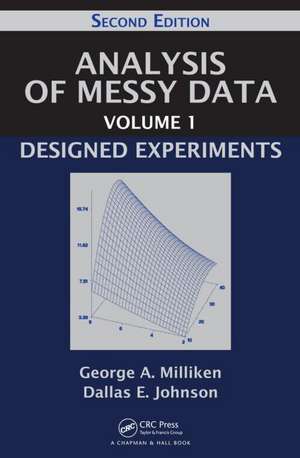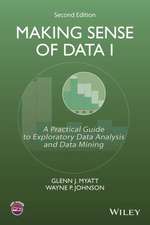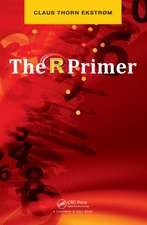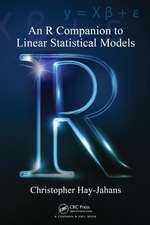Analysis of Messy Data Volume 1: Designed Experiments, Second Edition
Autor George A. Milliken, Dallas E. Johnsonen Limba Engleză Hardback – 2 mar 2009
New to the Second Edition
- Several modern suggestions for multiple comparison procedures
- Additional examples of split-plot designs and repeated measures designs
- The use of SAS-GLM to analyze an effects model
- The use of SAS-MIXED to analyze data in random effects experiments, mixed model experiments, and repeated measures experiments
Preț: 975.80 lei
Preț vechi: 1190.00 lei
-18% Nou
Puncte Express: 1464
Preț estimativ în valută:
186.74€ • 202.77$ • 156.86£
186.74€ • 202.77$ • 156.86£
Carte tipărită la comandă
Livrare economică 22 aprilie-06 mai
Preluare comenzi: 021 569.72.76
Specificații
ISBN-13: 9781584883340
ISBN-10: 1584883340
Pagini: 688
Ilustrații: 100 b/w images
Dimensiuni: 178 x 254 x 36 mm
Greutate: 1.32 kg
Ediția:Revizuită
Editura: CRC Press
Colecția Chapman and Hall/CRC
ISBN-10: 1584883340
Pagini: 688
Ilustrații: 100 b/w images
Dimensiuni: 178 x 254 x 36 mm
Greutate: 1.32 kg
Ediția:Revizuită
Editura: CRC Press
Colecția Chapman and Hall/CRC
Public țintă
Professional and Professional Practice & DevelopmentCuprins
The Simplest Case: One-Way Treatment Structure in a Completely Randomized Design Structure with Homogeneous Errors. One-Way Treatment Structure in a Completely Randomized Design Structure with Heterogeneous Errors. Simultaneous Inference Procedures and Multiple Comparisons. Basics for Designing Experiments. Multilevel Designs: Split-Plots, Strip-Plots, Repeated Measures, and Combinations. Matrix Form of the Model. Balanced Two-Way Treatment Structures. Case Study: Complete Analyses of Balanced Two-Way Experiments. Using the Means Model to Analyze Balanced Two-Way Treatment Structures with Unequal Subclass Numbers. Using the Effects Model to Analyze Balanced Two-Way Treatment Structures with Unequal Subclass Numbers. Analyzing Large Balanced Two-Way Experiments Having Unequal Subclass Numbers. Case Study: Balanced Two-Way Treatment Structure with Unequal Subclass Numbers. Using the Means Model to Analyze Two-Way Treatment Structures with Missing Treatment Combinations. Using the Effects Model to Analyze Two-Way Treatment Structures with Missing Treatment Combinations. Case Study: Two-Way Treatment Structure with Missing Treatment Combinations. Analyzing Three-Way and Higher-Order Treatment Structures. Case Study: Three-Way Treatment Structure with Many Missing Treatment Combinations. Random Effects Models and Variance Components. Methods for Estimating Variance Components. Methods for Making Inferences about Variance Components. Case Study: Analysis of a Random Effects Model. Analysis of Mixed Models. Case Studies of a Mixed Model. Methods for Analyzing Split-Plot Type Designs. Methods for Analyzing Strip-Plot Type Designs. Methods for Analyzing Repeated Measures Experiments. Analysis of Repeated Measures Experiments When the Ideal Conditions Are Not Satisfied. Case Studies: Complex Examples Having Repeated Measures. Analysis of Crossover Designs. Analysis of Nested Designs. Appendix. Index.
Recenzii
"…Every chapter has been systematically re-written for greater clarity, and added explanatory material has been inserted throughout. Many new diagrams and redrawn diagrams have been provided; those that show how to lay out the experimental designs are just superb and extraordinarily clear. The reference list has increased … . This revision is highly recommended to those who plan and analyze experiments of the type described."
—International Statistical Review (2009), 77, 2
—International Statistical Review (2009), 77, 2
Notă biografică
George A. Milliken, Dallas E. Johnson
Descriere
A bestseller for nearly 25 years, this book helps applied statisticians and researchers effectively analyze the kinds of nonstandard data sets encountered in the real world. Written by two long-time researchers and professors, this second edition has been fully updated to reflect the many developments that have occurred since the original publication. This edition includes several modern suggestions for multiple comparison procedures as well as additional examples of split-plot designs and repeated measures designs. It also uses SAS-GLM to analyze unbalanced effects models and SAS-MIXED and JMP to analyze data in random effects, mixed model, and repeated measures experiments.








